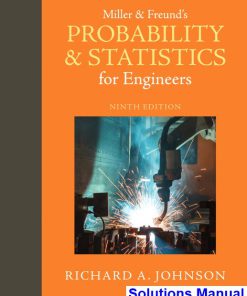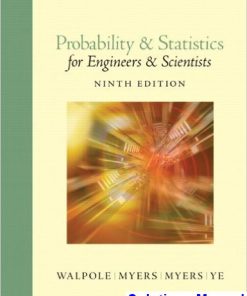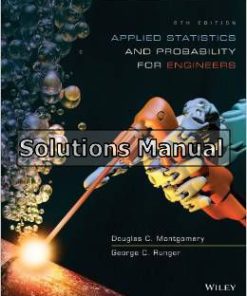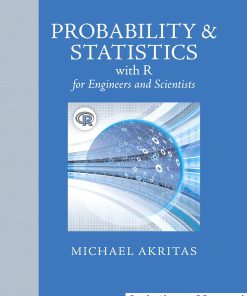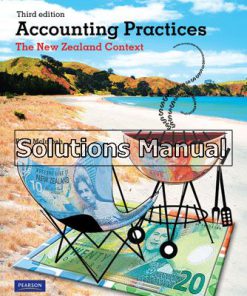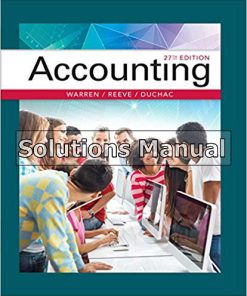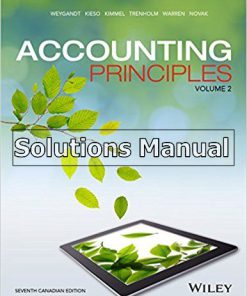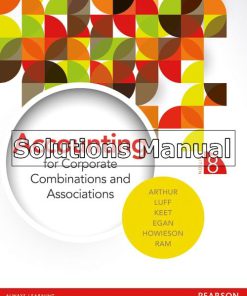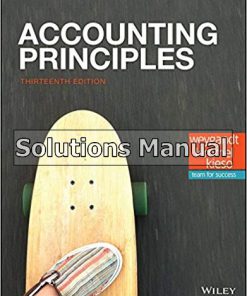Probability and Statistics for Engineers 5th Edition Scheaffer Solutions Manual
$26.50$50.00 (-47%)
Probability and Statistics for Engineers 5th Edition Scheaffer Solutions Manual.
You may also like
Probability and Statistics for Engineers 5th Edition Scheaffer Solutions Manual

Product details:
- ISBN-10 : 0534403026
- ISBN-13 : 978-0534403027
- Author: Richard L. Scheaffer
PROBABILITY AND STATISTICS FOR ENGINEERS provides a one-semester, calculus-based introduction to engineering statistics that focuses on making intelligent sense of real engineering data and interpreting results. Traditional topics are presented thorough an accessible modern framework that emphasizes the statistical thinking, data collection and analysis, decision-making, and process improvement skills that engineers need on a daily basis to solve real problems. The text continues to be driven by its hallmark array of engineering applications–thoroughly expanded and modernized for the 5th edition–which tackle timely, interesting, and illuminating scenarios that show students the rich context behind the concepts. Within the presentation of topics and applications the authors continually develop students’ intuition for collecting their own real data, analyzing it with the latest graphical tools, and interpreting the results with a goal of improving quality control and problem-solving process. Students will not only gain solid understanding of concepts and their real-life practicality, but will learn to become active statistical practitioners for their own future careers.
Table contents:
1. DATA COLLECTION AND EXPLORING UNIVARIATE DISTRIBUTIONS Introduction. A model for problem solving and its application. Types of data and frequency distribution tables. Tools for describing data: Graphical methods. Graphing Categorical Data. Graphing Numerical Data. Visualizing distributions. Tool for Describing Data: Numerical measures. Measures of Center. Measures of Position. Measures of variation (or spread). Reading Computer Printouts. The effect of shifting and scaling of measurements on summary measures. Summary Measures and Decisions. The Empirical Rule. Standardized Values and z-scores. Boxplots. Detecting Outliers. Summary. Supplemental Exercises.
2. EXPLORING BIVARIATE DISTRIBUTIONS AND ESTIMATING RELATIONS Introduction. Two-way table for categorical data. Time series analysis. Scatterplots: Graphical analysis of association between measurements. Correlation: Estimating the strength of linear relation. Regression: Modeling linear relationships. The Coefficient of Determination. Residual Analysis: Assessing the adequacy of the model. Transformations. Reading Computer Printout. Summary. Supplemental Exercises.
3. OBTAINING DATA. Introduction. Overview of methods of data collection. Planning and Conducting Surveys. Planning and Conducting Experiments. Completely Randomized Design. Randomized Block Design. Planning and Conducting an Observational Study. Summary. Supplemental Exercises.
4. PROBABILITY. Introduction. Sample space and relationships among events. Definition of probability. Counting rules useful in probability. Conditional probability and independence. Rules of probability. Odds, odds ratios, and risk ratio. Summary. Supplemental Exercises.
5. DISCRETE PROBABILITY DISTRIBUTIONS. Introduction. Random variables and their probability distributions Expected values of random variables. The Bernoulli distribution. The Binomial distribution. The Geometric and Negative Binomial distributions. The Geometric distribution. The Negative Binomial distribution. The Poisson distribution. The hypergeometric distribution. The Moment-Generating Function. Simulating probability distributions. Summary. Supplementary Exercises.
6. CONTINUOUS PROBABILITY DISTRIBUTIONS. Introduction. Continuous random variables and their probability distributions. Expected values of continuous random variables. The Uniform distribution. The exponential distribution. The Gamma distribution. The Normal distribution. The Lognormal Distribution. The Beta distribution. The Weibull distribution. Reliability. The Moment-generating Functions for Continuous Random Variables. Simulating probability distributions. Summary. Supplementary Exercises.
7. MULTIVARIATE PROBABILITY DISTRIBUTIONS. Introduction. Bivariate and Marginal Probability Distributions. Conditional Probability Distributions. Independent Random Variables. Expected Values of Functions of Random Variables. The Multinomial Distribution. More on the Moment-Generating Function. Conditional Expectations. Compounding and Its Applications. Summary. Supplementary Exercises.
8. STATISTICS, SAMPLING DISTRIBUTIONS, AND CONTROL CHARTS. Introduction. The sampling distributions. The sampling distribution of X (General Distribution). The sampling distribution of X (Normal Distribution). The sampling distribution of sample proportion Y/n (Large sample). The sampling distribution of S² (Normal Distribution). Sampling Distributions: The multiple-sample case. The sampling distribution of (X1 – X2). The sampling distribution of XD. The sampling distribution of (^p1 – ^p2). The sampling distribution of S²1/S²2. Control Charts. The X-Chart: Known ? and ?. The X and R-Charts: Unknown ? and ?. The X and S-Charts: Unknown ? and ?. The p-Chart. The c-chart. The u-chart. Process Capability. Summary. Supplementary Exercises.
9. ESTIMATION. Introduction. Point estimators and their properties. Confidence Intervals: The Single-Sample Case. Confidence Interval for ?: General Distribution. Confidence Interval for Mean: Normal Distribution. Confidence Interval for Proportion: Large sample case. Confidence interval for ?². Confidence Intervals: The Multiple Samples Case. Confidence Interval for Linear Functions of Means: General Distributions. Confidence Interval for Linear Functions of Means: Normal Distributions. Large Samples Confidence Intervals for Linear Functions of Proportions. Confidence Interval for ?²2/?²1: Normal distribution case. Prediction Intervals. Tolerance Intervals. The Method of Maximum Likelihood. Bayes Estimators. Summary. Supplementary Exercises.
10. HYPOTHESIS TESTING. Introduction. Terminology of Hypothesis Testing. Hypothesis Testing: The Single-Sample Case. Testing for Mean: General Distributions Case. Testing a Mean: Normal distribution Case. Testing for Proportion: Large Sample Case. Testing for Variance: Normal Distribution Case. Hypothesis Testing: The Multiple-Sample Case. Testing the Difference between Two means: General Distributions Case. Testing the Difference between Two means: Normal Distributions case. Testing the difference between the means for paired samples. Testing the ratio of variances: Normal distributions case. ?² tests on Frequency data. Testing parameters of the multinomial distribution. Testing equality among Binomial parameters. Test of Independence. Goodness of Fit Tests. ?² Test. Kolmogorov-Smirnov test. Using Computer Programs to Fit Distributions. Acceptance Sampling. Acceptance Sampling by Attributes. Acceptance Sampling by Variables. Summary. Supplementary Exercises.
11. ESTIMATION AND INFERENCE FOR REGRESSION PARAMETERS. Introduction. Regression models with one predictor variable. The probability distribution of random error component. Making inferences about slope. Estimating slope using a confidence interval. Testing a hypothesis about slope. Connection between inference for slope and correlation coefficient. Using the simple linear model for estimation and prediction. Multiple regression analysis. Fitting the model: The least-squares approach. Estimation of error variance. Inferences in multiple regression. A test of model adequacy. Estimating and testing hypothesis about individual parameters. Using the multiple regression model for estimation and prediction. Model building: A test for portion of a model. Other regression models. Response surface method. Modeling a time trend. Logistic regression. Checking conditions and some pitfalls. Checking conditions. Some pitfalls. Reading printouts. Summary. Supplemental Exercises.
12. ANALYSIS OF VARIANCE. Introduction. Review of Designed Experiments. Analysis of Variance (ANOVA) Technique. Analysis of Variance for Completely Randomized Design. Relationship of ANOVA for CRD with a t test and Regression. Equivalence between a t test and an F test for CRD with 2 treatments. ANOVA for CRD and Regression Analysis. Estimation for Completely randomized design. Analysis of Variance for the Randomized Block Design. ANOVA for RBD. Relation between a Paired t test and an F test for RBD. ANOVA for RBD and Regression Analysis. Bonferroni Method for Estimation for RBD. Factorial Experiments. Analysis of variance for the Factorial Experiment. Fitting Higher Order Models. Summary. Supplemental Exercises. APPENDIX. REFERENCES.
People also search:
applied statistics and probability for engineers 5th edition
applied statistics and probability for engineers 5th edition solutions
introduction to probability and statistics for engineers and scientists 5th
applied statistics and probability for engineers 5th edition solution pdf
what is probability and statistics for engineers
probability and statistics rules

